The weeks since the last trip had seen the weather stabilise a bit and temperatures rise so we had hopes for a good trip toWales and where ever else. There wasn't a lot of preparation to do on the boat which was lucky as I was busy doing some work at home but as the departure time arrived the weather forecasts indicated a possibility of a trip north to the Isle of Man before going south to Wales. Humberto from Madrid flew in on Thursday evening and we had a trip out on Friday to get him accustomed to the boat as he hadn't been on board in 8 years.The wind was initially light but it built to a solid 5 and gusty so he had a good initiation as we sailed across Dublin Bay. On arriving back we stowed our stuff and shopped before Claire and Anne arrived. Claire was to be onboard for 3 weeks and Anne for the weekend along the Irish coast. On Saturday morning I checked the long range forecast again but it showed stronger winds to the north for much of the week so we decided to skip the isle of Man and head south to Wicklow before going to Wales.
The winds were similar to the previous day so we had fun going across Dublin Bay with 2 reefs in the main to keep the boat stable in the gusts. Since we had tourists on board, we stayed close to the coast the whole way down enjoying the views. 8 miles from Wicklow the wind ease and with the tide starting to go against us, we had to motor the rest of the way. As we approached the harbour we could see a rain cloud was coming our way and it hit us as we lowered the mainsail. Unfortunately the skipper had not fully wound in the headsail so the wind gusting over 20 knots managed to unfurl part of it which took us 20 minutes to sort out. Lesson learnt by the silly skipper: make sure the headsail is properly rolled in!! Anyway, by the time we were entering the harbour, the winds had eased and we were back under Anne's control so we moored without further fuss.
The next day the forecast was for similar weather with winds easing that night so I decided to stay a further day to chill out and leave early on the Monday. We had a long walk along the coast to Wicklow Head lighthouses, of which there are 3. It was lovely to stroll along in the sun watching boats go by racing to Arklow. That afternoon we took out a friend of Claire's and his son who live in Wicklow. Initially it was light and pleasant but it gusted again to over 20 knots for the last half hour. This time the skipper had learnt his lesson and made sure to take in the sails properly so we got back in without a problem. Sadly, Anne had to leave after lunch to get the train back to Dublin, and then there were three left to think about the trip across the following day. The forecast seemed to continue to talk of light winds from the west going to the south or southeast later. This was confirmed in the sailing club by a friendly local using the internet later. So we had a shower, a couple of pints and food before heading to bed relaxed after our long day.
Monday morning brought sun and light winds. We set off with the hope of sailing
but the expectation of motoring most of the way. After leaving the coast we
found uncomfortable seas with little wind, the turbulence caused by the strong
tides passing over the uneven seabed. On reaching the end of the overfalls,
3 hours out, the winds came up a little from the southwest, a nice sailing
angle when you are going east. We set the yankee initallly but soon realised
that the wind was light enough for the cruising chute which is a lot of work.
The skipper made it worse by deciding to try putting a spinnaker pole on it
which turned out to be messy and caused the sail to twist so that it had to
be brought down (who invited the skipper on this trip? he seems to be a liability...).
Anyway, we dropped it and sorted it out and then raised it for the rest of
the trip. The wind was very stable 12-15 knots for the rest of the trip and
we sailed on slight seas. We were aiming for the southern entrance between
Anglesea Island and mainland Wales, an area known as the Menai Straits. For
those who had ever taken the ferry to Holyhead, you cross over the Straits
on a high bridge about an hour from Holyhead. The southern entrance is wide
and shallow, with a well buoyed channel to guide you in. We had an approximate
location of the buoys, but the channel shifts each winter so it was imperative
to see the first marker to guide you in. In Wicklow we were warned that the
markers can be difficult to see in southwest winds as the waves hide them.
About a half a mile south of where we thought it would be, we found the safe
water mark and the rest of the markers followed easily from there so we got
in easily enough. In no time we were in past the bar and heading the short
distance to Caernarfon, the ancient home of the Princes of Wales, and where
the current one was crowned. The light of the declining sun made the castle
all the more impressive as we approached. We tied up in Voctoria Dock and
rewarded ourselves with a lovely pint before dinner and bed.
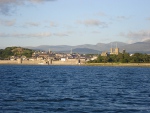
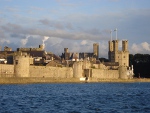
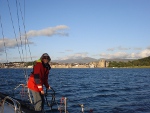
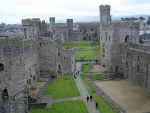
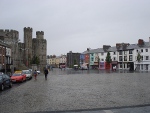
We stayed two nights in Caernarfon with drizzly rain on and off. The main part of the town is quite touristy inside the old town walls, with a grid of narrow streets. The castle itself was never finished fully and today they have simply made it safe rather than renovating it fully. There are some museums detailing its royal and military importance and you could see from its location why it was so important. The town around it is ok but the walk along the water's edge is very pleasant. After two days it was time to move on, but with continuing strong winds forecast, we didn't go far, just 3 miles to Port Dinorwick, now known by its Welsh name as Y Felinheli. Indeed, I was surprised how much Welsh I heard spoken. Years ago, when I was in Llanberis canoeing and climbing, you would occasionally hear people speaking it a bit this trip most people used it. Anyway, Dinorwick Marina is in a harbour built for ships to load slate which was brought down by train from Llanberis, about 10 miles away. It is a quiet place, with little movement of boats. We went for a long walk looking for a view of the Swellies, a narrow channel between rocks 2 miles north of us. In the end we didn't find it but it was good to get out for a stroll nonetheless.
The next morning Jane arrived for a few days and took us off by car into
the Welsh countryside. We went to Beddgelert, a place I had canoed in many
years ago. We went hiking along the Aberglaslyn gorge which was running at
a good level due to the recent rain, reminding me of how much my former life
revolved around a different kind of water. On reaching the end of the gorge
we went up through the heather, following the route of an old cable car used
to bring out copper mined here many years before. High up we even found some
of the tunnels into the mountain. From the top we had magnificent views of
the mountains with Snowddon to the north and the sea near Porthmadog to the
south. Our steep descent was rewarded with delights from an award winning
ice cream shop, yumm.......
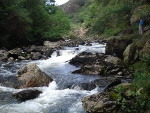
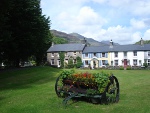
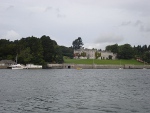
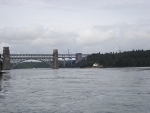
The weather which had been windy and rainy for 4 days finally looked to be clearing the dext day as we motored out at 10 am to go through the Swellies. We had been able to see it from the far bank after our hike as Jane had kindly returned that way after a lovely drive past Snowdon. We had no wind as we approached the narrows and all were prepared to concentrate on the tricky passage. In the end, despite having up to 3 knots of tide, Clare steered us well through and past the lovely scenery. On passing under the second bridge the Straits opened up and both sides became more populated with some really impressive mansions. We continued north and out to the open sea. The light winds came up a bit and soon we were on the cruising chute. After 30 mins it came up more so we we dropped it and soon enough we were on a double reef as the wind started to gust up towards 20 knots. We had a strong tide helping us as we followed the north coast of Anglesea. Jane was on the helm at this time but coped well with the conditions. As we went further west the wind rose until it gusted over 25 knots. So much for the forecast of light winds ! The one area of concern on this coast is Carmel Head 5 miles north of Holyhead where the tide of up to 6 knots runs over an uneven seabed, creating overfalls on uneven sea. If the wind is going a different direction to the tide, this can create steep waves which can be dangerous. As we approached the headland, the wind rose to a solid force 7 with almost 40 knots over the deck. As we went to roll away the yankee headsail, the strain of the wind on it caused the rope we use to roll it in to break. That meant that we had to go forward to pull the sail down in an hurry, a bit nervewracking but it came down ok. Now with the third reef in the main, we motorsailed very close to the headland to avoid the worst of the overfalls. But with so much wind we couldn't avoid them and we pounded into steep seas for 200 metres. After that the seas were less steep but still needed concentration on the helm to keep us on course and keep the mainsail filled. The skipper by now was fairly wet with some of the waves coming over the coachroof but in an hour we were safely inside the harbour wall as the winds started to ease. A fairly relaxing end to an eventful journey and once again we were glad that Suckin' Diesel was such a solidly built boat which looked after the crew so well.
That evening Anne was due to arrive on a ferry from Ireland for a few days. So after dinner and a couple of pints in the friendly yacht club, Humberto and I went off the the ferryport to meet the "real" skipper. The following morning was warm and dry as we headed off of a hike up Holyhead Mountain. Along the way we were able to get a view of the overfalls at North and South Stack lighthouses, again unsettled choppy seas due to the tide. The walks on the mountain are well marked with great views. Humberto was sad to be leaving later and wondered when he would see the sea again as Madrid is far inland. It made me realise how lucky I am to spend so much time at sea. I for one find it very therapeutic. We all went for a stroll through the town to see him off with Jane trying to find the best teahouse for him. The town wasn't as rundown as I had thought and we found a good butcher for a roast beef dinner to celebrate a forecast for improving weather (it takes little to bring on a party with us...). Sunday was a brighter day but with less wind as we motored east back along the north coast of Anglesea towards Conwy. We were able to sail under cruising chute for an hour or so but evantually the wind died and we motored on looking for the safe water mark indicating the twisting channel to Conwy. The channel was well marked but busy with Sunday day trippers heading out, mostly in motorboats. We found the tide stron in the narrows near the marina, but Anne brought SD in smoothly, gently easing out of the current as we approached the narrow marina entrance.
Conwy is another walled town built by King Edward 1 of England to show his dominance over the Welsh. The castle was very similar to the one in Caernarfon and the town marked out in a similar grid pattern. Being so near Liverpool, it is very touristy and much less Welsh than Anglesea. We spent three nights there, with Jane leaving the first afternoon. We generally chilled, walked and ate during our time there. Christine joined us on tuesday and on wednesday we headed back to Holyhead on calm seas. Fog descended early on in the trip making things interesting at times. It eased a bit 5 miles from the marina but on rounding the outer harbour wall it came down much worse and we had to crawl our way slowly hugging the harbour wall to find the entrance to the marina. An hour later it was much better and the forecast gave it to be better for the next couple of days. So we were set for an long day in Holyhead and the crossing back to Ireland on the friday. We had hot weather for another hike on Holyhead mountain and the reward of ice cream after. We even visited the coastguard station as Christine knew the staff. Claire found it very interesting to see how the people we speak to on the radio do their work.
The next morning, with a forecast of light winds we left to head back across the Irish Sea. The wind was not enough to sail so we motored on calm seas all the way with little to do except to monitor the shipping traffic crossing. Before you knew it we were entering the channel to Malahide again, the end of another summer sailing. Lots of weather this year, but at least we made the most of what we were given.